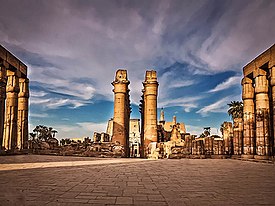About Luxor City
Luxor (Arabic: الأقصر, romanized: al-ʾuqṣur, ‘the palaces’) is a modern city in Upper (southern) Egypt which includes the site of the Ancient Egyptian city of Thebes.
Luxor is the “world’s greatest open-air museum”. As the ruins of the Egyptian temple complexes at Karnak and Luxor stand within the modern city. Immediately opposite, across the River Nile, lie the monuments, temples and tombs of the west bank Theban Necropolis, which includes the Valley of the Kings and Valley of the Queens. Thousands of tourists from all around the world arrive annually to visit Luxor’s monuments. Contributing greatly to the economy of the modern city.
In addition The population of Luxor is 422,407 (2021), with an area of approximately 417 km2 (161 sq mi). It is the capital of Luxor Governorate. It is among the oldest inhabited cities in the world.
Etymology
The name Luxor (Arabic: الأقصر, romanized: al-ʾuqṣur, ‘the palaces’, pronounced , Egyptian Arabic pronunciation: [ˈloɡsˤor], upper Egyptian: [ˈloɡsˤor]) derives from the Arabic (قصر), meaning “castle” or “palace”. It may be equivalent to the Greek and Coptic toponym τὰ Τρία Κάστρα ta tria kastra and ⲡϣⲟⲙⲧ ⲛ̀ⲕⲁⲥⲧⲣⲟⲛ pshomt enkastron respectively, which both mean “three castles”)
The Sahidic Coptic name Pape, comes from Demotic Ỉp.t “the adyton”, which, in turn, is derived from the Egyptian. The Greek forms Ἀπις and Ὠφιεῖον come from the same source. The Egyptian village Aba al Waqf (Arabic: أبا الوقف, Ancient Greek: Ωφις) shares the same etymology.
Also The Greek name is Thebes (Ancient Greek: Θῆβαι) or Diospolis. The Egyptian name of the city is Waset, also known as Nut (Coptic: ⲛⲏ).
History of Luxor
Luxor was the ancient city of Thebes, the capital of Upper Egypt during the New Kingdom, and the city of Amun, later to become the god Amun-Ra. The city was regarded in the ancient Egyptian texts as wAs.t (approximate pronunciation: “Waset”), which meant “city of the sceptre”, and later in Demotic Egyptian as ta jpt (conventionally pronounced as “tA ipt” and meaning “the shrine/temple”, referring to the jpt-swt, the temple now known by its Arabic name Karnak, meaning “fortified village”), which the ancient Greeks adapted as Thebai and the Romans after them as Thebae.
People firstly, called Thebes as “the city of the 100 gates”. Sometimes “southern Heliopolis” (‘Iunu-shemaa’ in Ancient Egyptian), to distinguish it from the city of Innu or Heliopolis . The main place of worship for the god Ra in the north. It also often belonged to as niw.t. which simply means “city”, and was one of only three cities in Egypt for which this noun. It is also niw.t rst, “southern city”, as the southernmost of them.





Comment (0)